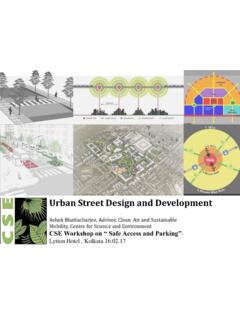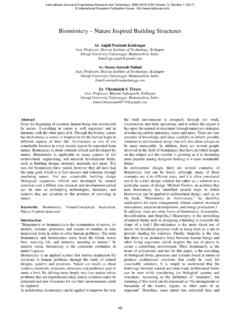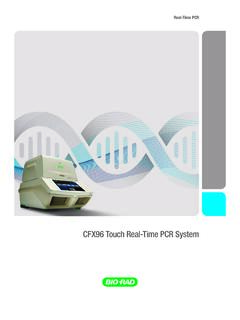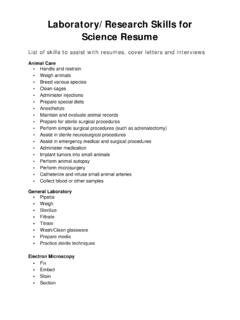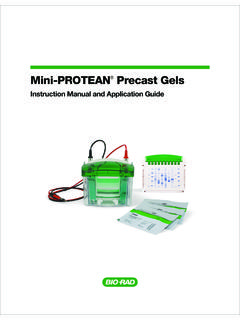Transcription of Bioretention Basins/Rain Gardens
1 Florida Field Guide to Low Impact Development Bioretention Basins/Rain Gardens Depiction of typical Bioretention area design illustrating shallow slopes, well drained soil profile and location of plant material along hydrologic gradient. Basins with large catchments should include an over drain or provide a spillway in case of high flow event, and underdrains can be used in areas with low conductivity soils. Definition: Objectives: A Bioretention area or rain garden is a shallow Bioretention Basins/Rain Gardens retain, filter, and planted depression designed to retain or detain treat stormwater runoff using a shallow depression stormwater before it is infiltrated or discharged of conditioned soil topped with a layer of mulch downstream.
2 While the terms rain garden and or high carbon soil layer and vegetation tolerant Bioretention basin may be used interchangeably, of short-term flooding. Depending on the design , they can be considered along a continuum of size, they can provide retention or detention of runoff where the term rain garden is typically used to water and will trap and remove suspended solids describe a planted depression on an individual and filter or absorb pollutants to soils and plant homeowner's lot, where the lot comprises the material.
3 Extent of the catchment area. Bioretention basins serve the same purpose but that more technical Overview: term typically describes larger projects in Bioretention basins can be installed at various community common areas as well as non- scales, for example, integrated with traffic calming residential applications. measures in suburban parks and in retarding basins. In larger applications, it is considered good practice to have pretreatment measures ( vegetated strips and swales) upstream of the basin Applications to capture sediment and reduce the maintenance Residential yards (most frequency of a Bioretention basin.)
4 Common in smaller, urban The size of the rain garden or Bioretention area sites) will determine the volume of runoff that can be Commercial developments stored or reduced, as well as the treatment benefits. Parking lot islands Where the volume of runoff exceeds that of the Roadways (off-line cells Bioretention area, additional stormwater devices adjacent to roadways will be required in the treatment train to handle accessed by curb cut) the design storm. 2008 University of Florida Program for Resource Efficient Communities 1.
5 Florida Field Guide to Low Impact Development A Bioretention area/rain garden is used to Benefits encourage infiltration, so place it in an area Pollutant removal through where infiltration is good, not where water infiltration and plant normally pools. It should be at least 10 ft. from any absorption building, to avoid moisture around the building's Reduction of water runoff foundation. Don't place a rain garden over a septic from site system. Consider how it can be integrated into Reduced irrigation for existing and future landscaping.
6 When adding planting beds plant material, do not place woody plants in the inflow path. Use native plants to improve the site's Increased biodiversity in the landscape with wildlife and biodiversity. aesthetic values Operations and Maintenance: When rain Gardens are installed on individual lots, it is important to implement educational Water Protection Benefits: programming to homeowners on proper Bioretention basins use vegetation in retention maintenance. It is also important that the storage areas to reduce nutrient export through plant capacity of the rain garden/ Bioretention area uptake, filtering and sorption.
7 The vegetation also be maintained through regular maintenance improves soil infiltration. of vegetation and removal of debris that may Water conservation implications Biorention compromise any structures during a high flow basins are designed to capture and retain event. Regular visual inspection of the basin, stormwater in recessed Gardens that typically do looking for signs of erosion, excessive sediment not need irrigation beyond plant establishment. deposits or dead and diseased vegetation, should be conducted. Mulch in the Bioretention area Stormwater implications Infiltration processes should also be monitored for bare spots and should and adsorption to plant roots remove pollutants be replaced every 2-3 years.
8 Plant selection is from the flow stream. This is a key practice in the critical to aid operation, and other considerations LID suite for improving stormwater quality. This may include gravel or stone to limit volunteer also reduces the quantity of water flowing off-site growth that can reduce storage area. into the larger municipal stormwater system. design Considerations: This is an infiltration dependent practice affected design Keys by soil type and groundwater table. Where soils are The design of a Bioretention well drained and groundwater tables are well below area/rain garden is a balance the surface, an under drain is not required.
9 Where of stormwater function soils have low conductivity, underdrains can be with biological functions. used to reduce ponding time and increase treated That means there must be volume. There is no specific slope requirement consideration of: for Bioretention , although size of the basin will Basin design (soil type, typically decrease or become narrower and follow drainage, groundwater table, the elevation contour as slopes increase above 5%. slope, outfall device). Determination of ponding depth should consider Location in the treatment train inflow characteristics (inflow rate, total volume, Plant material selection and etc.)
10 , soil infiltration rate, and total ponding placement volume available. The ponding depth should not On-going management be greater than 12 inches, with 6-8 inch depths preferred. The duration of ponding after a storm should also not exceed 24 hours to reduce the likelihood of mosquito breeding or safety hazards. 2 2008 University of Florida Program for Resource Efficient Communities Florida Field Guide to Low Impact Development HOA or Regulatory Considerations: References and Resources: There is presently no regulatory presumption Bannerman, R.



